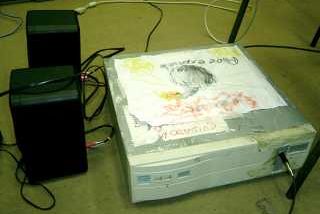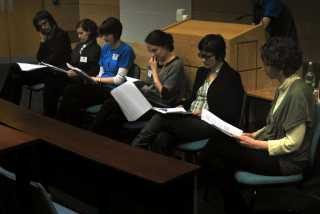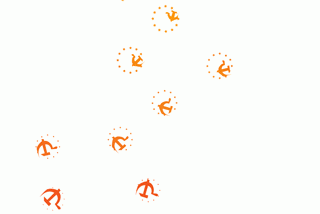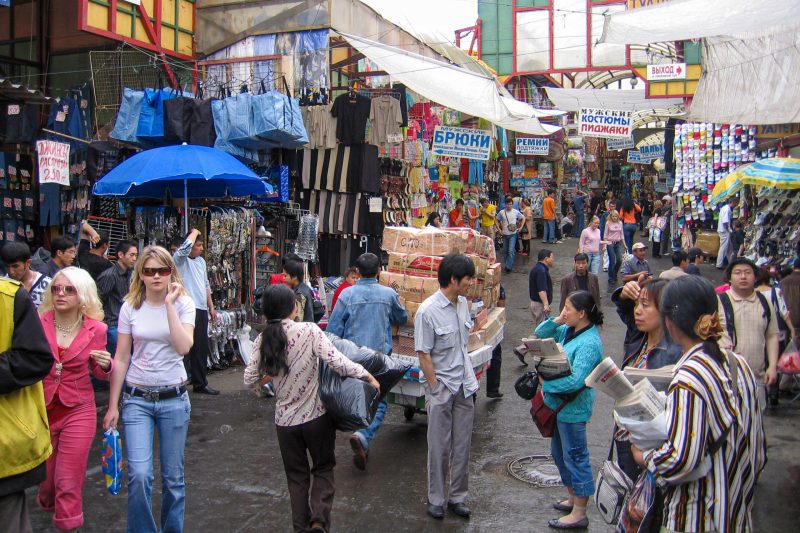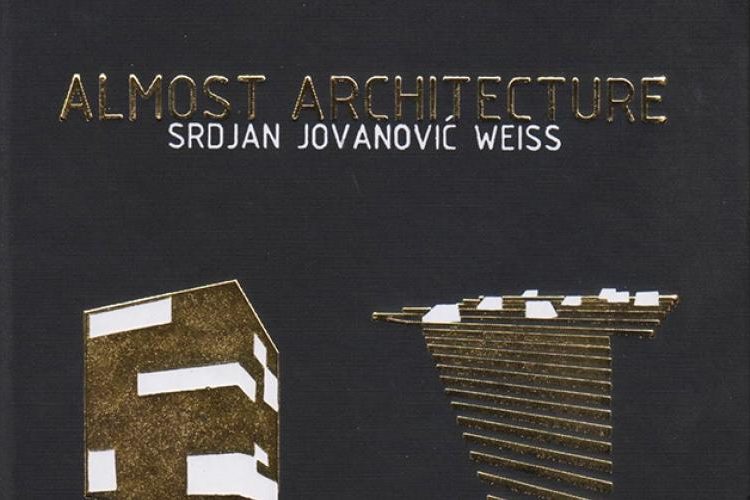- Felix Stalder
TRACING TRANSLOCALITY: The BlackBenz Race
The project BLACKBENZ RACE (BBR) by Knowbotic Research is a semi-fictional car race from Zurich to Pristina, Kosovo, and back again to Zurich (1). A convoy of black cars, decorated with Kosovo-Albanian iconography and stylized as improvised racing cars, start the race at the international bus station, located downtown, next to Zurich`s main train station. This is a highly public event replete with cars, music, food, and information stalls, put together by the artists as well as the Kosovo-Albanian community of Zurich. The race leads along one of Zurich`s main exit/entry roads, onto the highway, south into Italy, all the way to Bari where the ferry is boarded. Upon arrival in Durres, Albania, the race continues to Pristina. Here, at the turning point, a series of events are being staged, in collaboration with Dokufest, the international documentary film festival in Prizren. After that the race returns, via Macedonia and Italy, back to Zurich. The more direct route via ex-Yugoslavia cannot be taken, partly for security reasons (in Serbia), but partly also because the visa requirements for people who only hold an UNMIK (United Nations Mission in Kosovo) passport are more than onerous in these countries. At the end of the race, one of the cars is removed from circulation. It is exhibited for one year in a public parking spot and washed every week with a mobile car-washing unit, like the ones that can be found everywhere in Albania under the name of Lavaz.
During the race, LED panels are installed along the last few hundred meters of the main entry/exit road to Zurich, where, on the weekends, the tuned-up cars coming into town from the suburbs are stuck regularly in traffic jams. On the panels messages, sent in via mobile phones by the racing teams, are being displayed indicating the development of the race. On the project website, small video clips from mobile phones are being uploaded showing scenes from the race and the stops along the way. In this project, the black Mercedes car serves as a vehicle to examine public space in a place like Zurich and to trace the outlines of an emerging translocal space. Traditionally, public space is thought of as something entirely local, the proverbial village square, which in Switzerland has accumulated semantic layers. To this day, direct democracy takes place in some cantons in the form of assemblies on village squares, the Landsgemeinde. People coming together in one place, discussing public affairs in the open and making decisions on the spot, in full view of all elective members of the community, is the oldest form of democracy, originating in ancient Athens. Modern forms of democracy, developed in the 18th and 19th century, governed societies far too large to assemble physically in one spot. The mass media took the place of the village square, making sure that everyone could listen, though not speak, to the elected representatives who deliberated public affairs. Despite very significant differences within and between ancient and modern forms of democracy, the notion of public as relating to a unified, contiguous territory is constitutive for both. In the first case, the space of the village square is covered by the medium of the voice of the speaker, in the second, the space of the national territory is covered by the mass media, first print, then electronic.
BBR rests on the assumption that this notion of public space is being challenged by a new type of space that must be conceptualized quite differently. Rather than being local, contiguous and based on mass media, this new space is translocal, distributed, and based on what the sociologist Manuel Castells calls “the space of flows”. The space of flows consists of three layers. First is the physical layer, the material nodes of the network that create and administrate the flows. This includes specific buildings, roads, dedicated computer machinery, airports, communication wires, and so on. The second are the things that actually circulate, including people, materials and information. The third is a particular culture that facilitates the coordination of these elements, without which they would not coalesce into something stable enough to create space. The space of flows is best thought of as a myriad of translocal networks, held together by a continuous circulation of people, materials and bits, each characterized by a particular make-up of resources, and developing, over time, a unique culture that defines the boundaries of that space.
The key aspect of the space of flows – about which it is justified to speak as a unique space despite its constitutive fragmentation – is that it enables the connection of distributed entities to occur as if they were in one place, thus fundamentally affecting social geography.
This sociological concept echoes an older philosophical debate about the ontology of space, going back to the famous Clarke-Leibniz exchange (1715-16). Samuel Clarke, who served in this case as Newton`s proxy, defended an absolute notion of space against Leibniz`s relative one. Newton conceived space as an invariable entity independent of the objects that are placed within it. Such space can be empty or full and distances are absolute. This is, as seemingly self-evident common sense, how we conceptualize space today. Leibniz, on the other hand, conceived space as in-between things. For Leibniz, there could be no such thing as empty space because space did not exist prior to objects. Thus, space is relative, relating to the in-between of objects, rather than to an absolute, invariant measure.
In the present context, there is no need to get into the depth of this ongoing ontological debate about the nature of space. All that is necessary to remember right now is that we can think of space differently, as being characterized by the `in-between` of objects. Flows can be seen as the empirically observable `in-between`, as they connect one object with one or many others. Over the last decades, we have seen the development of an infrastructure for high-speed, high-precision, high-volume, low-cost flows substantially transforming the character of long-distance exchanges that have existed throughout history. While there is a lot of debate as to when this process started, it`s more obvious that in the 1990s this infrastructure has become accessible to a very wide range of people and organizations, rather than just the elite, as evidenced by the ubiquity of cell phones, easy internet access, satellite TV and low-cost airlines. From the point of view of physical urban spaces, the impact of the emergence of the space of flows is that of a deepening fragmentation. Physical proximity plays less and less a role in bringing together different entities that co-exist within one locality. Put somewhat schematically, the easier it is to create real-time interaction across distances, the less important is the fact that local co-presence enables real-time interaction as well. From within the networks, on the other hand, people and things that are geographically distant become quasi-locally present for real-time interaction. Thus, we have two interlocking movements, one is fragmentation (on the ground), the other is integration (through flows) of social processes and the particular cultures through which they are created.
However, one might ask, what does all of this have to do with black Mercedes cars racing between Zurich and Pristina? To understand this, it helps to get some background on the migration of Kosovo-Albanians to Switzerland. During the 1990s, the immigrant population from ex-Yugoslavia more than doubled to about 360,000 people. Roughly half of them are, in fact, Kosovo-Albanians who now constitute the largest immigrant group in the country. While the first were called upon as “guest-workers” in the 1960s, the majority came as refugees following the break-up of Yugoslavia at the end of the cold war. In many ways, they faced similar difficulties to earlier migrant groups in terms of discrimination, uncertain legal status, difficulties of integration, economic insecurity, and so on. However, in important respects, their experience was also very different from other groups. First, contrary to other recent immigrant groups, the Kosovo-Albanians are Europeans and thus the distances between the place of origin and the place of migration is relatively small. One can drive from Zurich to Pristina and back over a long weekend. And many do. Second, contrary to post-WWII immigration from Southern Europe, the means for local and international communication, the infrastructure of flows, has been widely available. Today, there are numerous Albanian newspapers in Switzerland, some produced in Kosovo, others in Switzerland, others jointly in both countries. Satellites make local Kosovo TV available in real time, internet portals not only provide topical information in great detail, but also enable the connection of migrant communities scattered across Europe. Cell-phones and, most recently, internet-based phones, support individual, real-time communication for people on the move, at low cost.
Taken together, an alien and often discriminatory environment which is making integration difficult, and the possibility for connecting, physically and informationally, with relative ease to people who either stayed back home or went to other parts of Europe, have been factors in the creation of a particular kind of translocal immigrant culture. Thus, one could say, the experience of most Kosovo-Albanians across Europe is one of a culture created in the space of flows. Seen from local public space, the most visible element of this culture are cars which play a central role in immigrant culture generally, and here in particular. Apart from their essential transportation role, they are over-coded with meaning. Quite generally, black limousines represent the weight of power, be that political or criminal. Cars can also represent individual freedom in a context that allows little such luxury to immigrants at the bottom of the social ladder. They also constitute, and represent, considerable investment. They indicate a certain status and, when driving home, the migrant`s success abroad. As an investment, cars are highly mobile, and turned into cash quite easily. Furthermore, cars are often gifts by parents to their children, to whom they have sometimes little else to offer. Being poorly integrated into a society in which their children are much more at home, can make parents dependent on the children, upsetting traditional family hierarchies.
In Switzerland, the high-powered car as the symbol of Kosovo-Albanian culture became particularly ingrained in the public`s mind when a sudden media hysteria broke out concerning high-speed car chases and fatal accidents caused by them. With overt racists overtones, it was not a co-incidence that this media campaign took place a few weeks before a general vote on whether to relax Switzerland`s very restrictive naturalization laws. Characteristically, the treatment of these illegal car races was markedly different from the favorable media reception that, around the same time, “gumball rallies” received. These rallies, named after a 1976 B-movie, are illegal car races across Europe, but for international jet setters in fancy cars who stay at expensive hotels, full of media hype about the rich and famous flaunting traffic regulations, while in the background, everything – one must assume – was well coordinated with the police.
For the local population, a car race, unless it`s done in circles on a track, is almost imperceptible, as cars pass quickly in and out of sight. It`s an event that is, almost unavoidably, semi-fictional, and also participants often are busy creating their own mystique. Scores of website collect little clips of illegal races, yet, it`s often not clear to which degree these clips represent real races, or are just edited for show, or both. BBR takes the race as a metaphor for the media-saturated translocal cultures, situated at the border between reality and fiction, between a self-determined telling of one`s own story through do-it-yourself media and heavy-handed discrimination through mass media. By showing the cars, both on the LED panels installed along a main artery of Zurich, and on the website, BBR creates a narrative space in which to examine both the myth and the reality of translocality, as constructed by a collaboration between artists and migrants. In this sense, it`s not a documentary project, as the framework in which all of this takes place, is semi-fictional. This should give greater freedom to explore the realities on the ground, as the cars move from one locale to another, with their own rhythm of speedy advances and forced delays at borders, ferry crossings, military checks, and so on. The exploratory part of observing how the racing cars, and the race as a whole, change their meaning according to different contexts, remains, of course, highly speculative, as the project has not (yet) been realized. At this stage, the project makes a series of tentative proposals about how to deal with the transformation of (public) space, artistically and theoretically, which is being fragmented and reintegrated under our very feet.
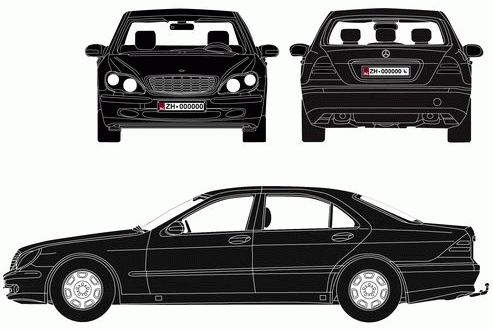
FOOTNOTE 1:
“BlackBenz Race” (BBR) was initiated as a commissioned work in 2005. It was one of five projects to re-examine the relationship between art and public space in the city of Zurich, Switzerland. Knowbotic Research invited Osman Osmani, Arben Gecai, and me to collaborate. While BBR has not been realized yet, Knowbotic Research transformed some elements of the project into a work suitable for a closed exhibition space. This text refers to the original conception.
References:
CASTELLS, Manuel (2000-04): The Information Age: Economy, Society and Culture. 2nd edition (3 vols). Cambridge, Blackwell.
KHAMARA, Edward J. (1993): “Leibniz`s Theory of Space: A Reconstruction,”
Philosophical Quarterly 43, p. 472-88.
RAUNIG, Gerald; WUGGENIG, Ulf (eds.) (2005): Publicum. Theorien der
Öffentlichkeit. Wien, Turia + Kant.
STALDER, Felix (2006): Manuel Castells and the Theory of the Network
Society. Cambridge, Polity Press.
WINSTON, Brian (1998): Media Technology and Society: A History from the Telegraph to the Internet. London, Routledge.
